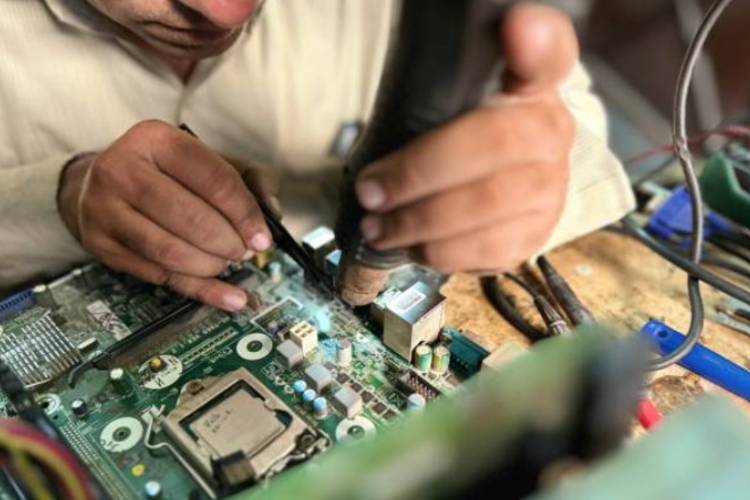In December 2021, the Union government launched a ₹76,000 crore incentive programme to build a domestic semiconductor ecosystem—a turning point in the country’s technology and industrial policy. The ambition is not just to meet domestic demand but to become a meaningful player in the global semiconductor value chain.
Semiconductors—now dubbed the “new oil”—power everything from smartphones and electric vehicles to satellites and AI processors. Despite being the second-largest smartphone market and a global leader in IT services, India has long remained absent from the high-stakes chip manufacturing arena. This is not merely a technology project; it is an exercise in industrial transformation involving skilling, global trade alignment, infrastructure creation, and geopolitical positioning.
READ | India’s CBDC: Policy vision with unproven demand
As India courts global majors such as Micron, Foxconn, and Tower Semiconductor, the central question is whether this initiative can spark a broader manufacturing renaissance, or if it will fall into the pattern of grand but under-executed policy schemes.
Silicon sovereignty and geo-economics
The global semiconductor supply chain is among the most complex and capital-intensive in the world—heavily concentrated in East Asia. Taiwan’s TSMC alone commands over half of the global foundry market, while South Korea and China dominate memory and mature node production.
The COVID-19 pandemic and the US-China tech decoupling exposed the vulnerability of these dense supply hubs. What followed was a wave of semiconductor nationalism. India’s push for chip self-reliance is both economic and strategic: reducing exposure to external supply shocks, safeguarding digital infrastructure, and positioning itself as a credible China-plus-one alternative.
In 2023, Micron announced a $2.75 billion assembly and testing plant in Gujarat, with the Indian government covering half the cost. The Vedanta-Foxconn joint venture, despite delays, reveals corporate India’s alignment with this strategic imperative.
However, silicon sovereignty is not synonymous with building fabs alone. India still imports nearly all its semiconductors. Without a coordinated approach covering upstream materials like high-purity silicon and rare earths, EDA (electronic design automation) tools, and intellectual property ownership, the country risks becoming a low-margin packaging base rather than a full-stack semiconductor hub.
AI, EVs, 5G, and the chip boom
Global semiconductor demand is being propelled by technologies such as artificial intelligence (AI), 5G networks, electric vehicles (EVs), the Internet of Things (IoT), and robotics. AI in particular has emerged as a key driver, fuelling demand for specialised chips like GPUs, TPUs, and AI accelerators for edge computing and hyperscale data centres.
The EV transition is generating surging demand for power semiconductors—especially those based on materials like silicon carbide and gallium nitride. The deployment of 5G infrastructure is creating demand for baseband processors and RF (radio frequency) chips, while the proliferation of IoT devices calls for low-cost, high-volume chip manufacturing—an area where India could leverage its traditional strength in cost competitiveness.
Yet, unless domestic fabs are capable of producing at least a segment of these advanced chips, innovation may continue to be exported for fabrication in East Asia. Linking India’s engineering base to its emerging chip infrastructure remains a critical challenge.
Make in India: Import substitution vs global integration
Semiconductors lie at the intersection of two key policy goals: boosting manufacturing and cutting India’s annual $19 billion electronics import bill. But building semiconductor fabrication plants is neither quick nor easy. A fab can cost more than $10 billion, requires uninterrupted water and power, high-precision cleanrooms, and—most importantly—policy consistency that transcends political cycles.
India’s earlier efforts, including the Semiconductor Complex Limited in Mohali, collapsed due to lack of ecosystem support and global integration. The current effort, aided by a 50% capital subsidy under the Modified Programme for Semiconductors and Display Fabs, is more realistic in design. It also echoes the playbooks of the US CHIPS Act and the EU’s Chips Act.
Yet, import substitution alone is a limited vision. Modern chip-making is a globally distributed process. India will need to plug into global value chains strategically—focusing on high-growth niches such as compound semiconductors (used in EVs and 5G), chip design, and advanced packaging.
One of India’s biggest advantages is its human capital. Over 20% of the world’s chip designers are based in India, with firms like Qualcomm, Intel, and Texas Instruments running their largest R&D operations here. Strengthening domestic design-led manufacturing, rather than racing to compete with entrenched players at the cutting edge of chip fabrication, may offer a more pragmatic pathway to global relevance.
Chips and the industrial maturity index
The semiconductor mission represents more than just another industrial policy initiative—it is a benchmark of India’s ability to execute high-complexity, high-value manufacturing at scale. If successful, it can transform India from a “design hub” into a “hardware powerhouse”—not just exporting software but building the machines that run it.
However, chip manufacturing is a long-haul enterprise. The global leaders in the field—Taiwan, South Korea, and the United States—took decades to build the necessary ecosystems. For India, the prerequisites are clear: patient capital, uninterrupted policy support, strong global alliances, and a deep talent pipeline aligned with future technologies.
The government’s $10 billion bet is a significant first step. But the semiconductor sector is unforgiving. In this space, intent matters less than execution. The next five years will reveal whether India’s semiconductor initiative becomes the foundation of a new industrial age—or a footnote in its policy playbook.
Naman Mishra is a doctoral researcher, School of Management, Bennett University, Greater Noida. Dr Vandana Sharma is Associate Professor, Christ University, Bengaluru.

